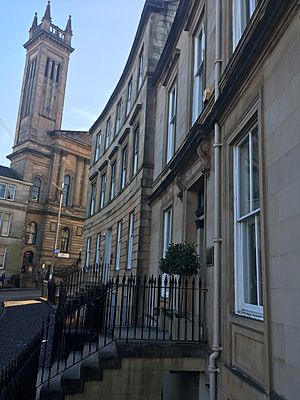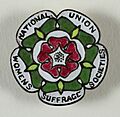Glasgow and West of Scotland Association for Women's Suffrage facts for kids
The Glasgow and West of Scotland Association for Women’s Suffrage was an important group that worked to get women the right to vote. This is called women’s suffrage. The association was based in Glasgow, Scotland, but had members from all over the west of the country.
Contents
How the Association Started
The Glasgow and West of Scotland Association for Women’s Suffrage first met in 1902. This first meeting took place at the home of Mrs. Greig, who was the founding president. Her home was at 18 Lynedoch Crescent in Glasgow.
The next year, in 1903, the association joined a bigger group called the National Union of Women's Suffrage Societies. This helped them work with other groups across the country. Until 1909, many of their meetings were held at the offices of the Scottish Council for Women's Trades. Mrs. Greig was also the president of the Glasgow Women's Liberal Association for many years. Other important members who also worked with the Scottish Council for Women's Trades included Alice McLaren, Elizabeth Margaret Pace, Grace Paterson, and Margaret Irwin.
What the Association Did
This group was known for being a non-militant suffrage association. This means they did not use violence or extreme protests. They wanted to achieve their goals through peaceful and legal ways. Even though they welcomed men as members, the association was mainly run and led by women.
Their main ways of influencing people included:
- Holding meetings: They had smaller "drawing-room" meetings where important speakers, both men and women, would talk about women's right to vote.
- Working with other groups: They connected with many other organizations, like The Primrose League and the Scottish Women's Liberal Federation. They also had strong ties with the Scottish Council for Women's Trades.
- Travelling around: Members of the association traveled throughout the west of Scotland. They gave speeches and helped set up new branches of the organization in towns like Greenock, Motherwell, and Kilmacolm. They even took their campaign to popular coastal resorts along the River Clyde, such as Helensburgh, Troon, and Dunoon. A branch was set up in Greenock in 1904.
In November 1907, some members of the association met with the Prime Minister, Lloyd George. Mrs. Hunter, a member, asked him to promise that the government would introduce a law to give women the right to vote before that Parliament ended.
During World War I, the association stopped its political campaigning. Instead, they organized a series of lectures. They made sure to say they were "non-party, non-militant" and "law-abiding." This helped people know they were different from more radical groups, like the Women's Social and Political Union, who sometimes used more aggressive methods.
After Women Got the Vote
After the Representation of the People Act 1918 was passed, some women over 30 finally got the right to vote. The association quickly changed its focus. They started working to help women get elected into local government positions.
They formed a new group called the Women's Local Representation Joint Committee. This committee included members from several different organizations that had similar goals. These groups worked together to promote laws that would be good for women. Mary Anderson Snodgrass chaired this committee. She later became a Town Councillor and a Bailie (a type of local official) in Glasgow.
In 1933, the original societies were closed down because of money problems. However, the women who were part of these groups continued to meet at the Queen Margaret Union at the University of Glasgow until the 1960s.
Important Members
Many dedicated people were part of the Glasgow and West of Scotland Association for Women’s Suffrage. Some of them included:
- Janie Allan
- Professor Edward Caird and Mrs. Caird
- Marion Gilchrist (Doctor)
- Mrs. Greig (who was the founding chair of the executive committee)
- Nellie Hunter
- Margaret Irwin (trade unionist)
- Dr. Thomas Martin Lindsay and Mrs. Lindsay
- Dr. Alice McLaren
- Dr. Elizabeth Margaret Pace
- Grace Paterson
- Mary Anderson Snodgrass
- Mrs. C Young (who was the Treasurer)
See also
- Feminism in the United Kingdom
- List of suffragists and suffragettes
- List of women's rights activists
- List of women's rights organizations
- Timeline of women's suffrage
- Women's suffrage organizations
Images for kids








